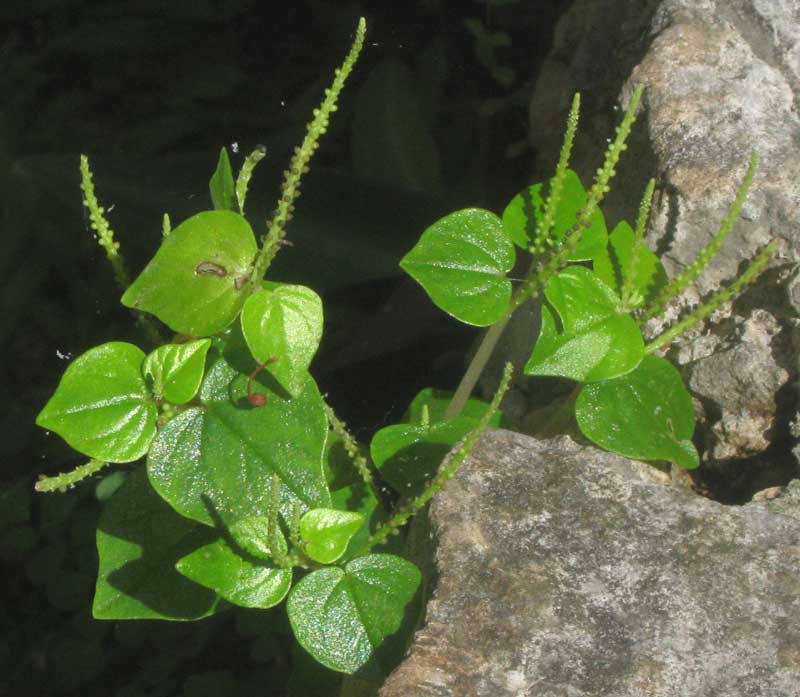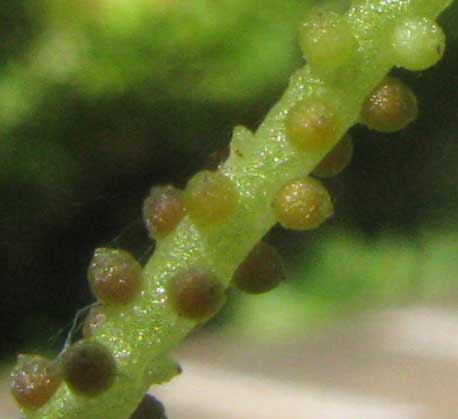Excerpts from Jim Conrad's
Naturalist Newsletter

from the November 13, 2011 Newsletter issued from Hacienda Chichen Resort beside Chichén Itzá Ruins; limestone bedrock; elevation ~39m (~128ft), N20.675°, W88.569°; central Yucatán state, MÉXICO
PEPEROMIA AT THE FISHPOND
For the last two years there was no plant growing in cracks between the fishpond's cemented-together stones like the dainty, hand-sized one shown above. Those slender, green flower spikes atop the plant immediately reveal the plant as a peperomia. Peperomias are often sold as indoor potted plants in the North. They belong to the Black Pepper Family, the Piperaceae, of strictly tropical and subtropical occurrence. The genus Peperomia embraces 1500-1700 species. Seven Peperomia species occur in southern Florida and about as many are known from the Yucatán. A close-up of our Peperomia's flower spikes is shown below:

Peperomia flowers are much simplified, lacking the usual calyx, corolla and whorl of stamens. They consist of two male stamens and a single ovary subtended by a single scale, or bractlet. The picture shows mature ovaries about to become fruits, the more mature ones arising toward the bottom. When you buy peppercorns for grinding into black pepper, those are fruits from Piper nigrum, a member of the Black Pepper Family, so the similarity of the darker Peperomia fruits to peppercorns isn't incidental.
Our fishpond peperomia was easy to distinguish from other species found here by two striking features: First, its leaves are broadly heart-shaped and; two, the ovaries on the spike rachis are very widely spaced from one another. The flowers of most Piper and Peperomia species are so congested that their ovary or fruit tops form a solid, mildly bumpy surface.
This is PEPEROMIA PELLUCIDA, native to humid tropical America and cultivated and naturalized throughout the rest of the world's tropics. That's also unusual for a Peperomia species, for most peperomias are much more restricted in distribution. You think of peperomias as being fussy about where they live, but Peperomia pellucida verges on being a weed.
Being so widespread, it goes by many names. Among its English ones Shiny Bush seems common, though the bush part hardly seems to fit. The USDA calls it Man-to-Man, and sometimes it's called Pepper-Elder, which seems the least inappropriate. Fact is, this plant just doesn't have a decent English name.
The other big thing about Peperomia pellucida is that in many places it's regarded as very medicinal. In fact, so many uses are listed for it that, again, you beginning doubting them all. I find mention of the plant being used for abdominal pain, abscesses, acne, boils, colic, fatigue, gout, headache, kidney problems, and rheumatic pain, and to treat breast cancer, impotence, measles, mental disorders, high cholesterol, coughing, heart flutter and smallpox. Scientific tests have indeed documented anti-inflammatory and analgesic properties exhibited by crude extracts from it. There are reports of exposure to the plant causing asthma-like symptoms in certain people.
Some authors say that its crushed herbage emits a strong mustard-like odor, but to me it smells sweetly minty with a only a hint of slightly oily, mustardy smell.